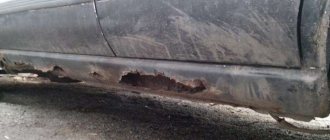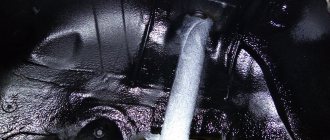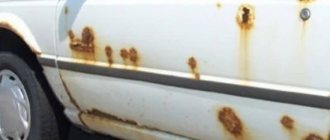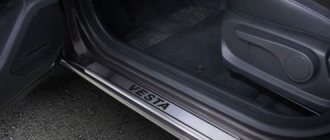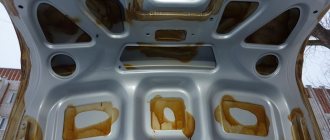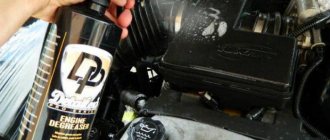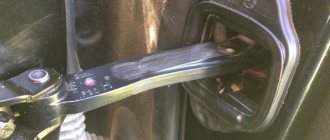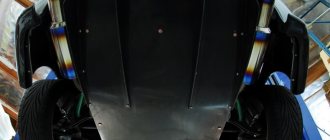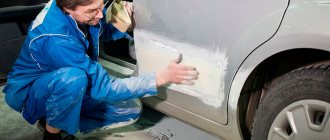Car thresholds (boxes) are one of the most problematic body elements after wheel arches. As a rule, arches, sills, and door edges are often damaged and are most susceptible to corrosion.
To protect thresholds, the following procedures must be carried out:
- internal threshold processing;
- external threshold protection.
Please note that these operations are carried out comprehensively. Internal treatment should be carried out to protect internal (hidden cavities) from moisture. External treatment involves protecting the paintwork of the threshold from chips and other damage in order to avoid the onset of active corrosion. Read more in our article.
Why do you need to additionally process thresholds?
Modern cars usually have minimal sill protection when leaving the factory. At the same time, thresholds for cars are often treated at the factory with “anti-gravel”, which is painted on top in the color of the body. Less often, some models additionally receive plastic door sills, etc.
It is important to understand that regardless of the type and quality of protection, during vehicle operation, thresholds require special attention for the following reasons:
- when getting in and out of a car, the threshold is often caught by shoes, damaging the paintwork;
- stones and sandblasting cause paint chips and deep scratches on the thresholds;
- collisions with obstacles, high curbs, errors when working with a lift or jack often lead to jamming of the thresholds;
- the adhesion of snow and ice mixed with salt and chemical reagents leads to active corrosion;
- insufficient ventilation of the thresholds leads to hidden internal corrosion of the closed box;
In all cases, the main problem is unprotected metal, which quickly begins to rust in winter. For these reasons, it is necessary to protect the thresholds from corrosion. Otherwise, you will need to replace the threshold, which is much more expensive than protecting the boxes.
What do you need to have to process thresholds yourself?
For anti-corrosion treatment of thresholds you will need:
- anti-corrosion composition;
- rust modifier;
- wire brush and abrasive;
- water;
- degreaser;
- rags;
- masking tape;
- protective equipment due to the toxicity of fumes (gloves, respirator, clothing that completely covers the skin, goggles).
Before starting work, be sure to read the instructions and fulfill all requirements. If it is not possible to carry out work in a warm garage or box, move it to the summer. In winter and autumn, such treatment is carried out in a warm room. Be sure to wash and dry the car before the procedure.
Anti-corrosion treatment of the threshold
How to treat thresholds from the inside
To protect car sills from corrosion inside the boxes, you need to perform anti-corrosion treatment. In this case, you can use both ready-made anti-corrosion compounds (for example, Rust-Stop for hidden cavities), and the well-known Movil in thresholds or other solutions.
At the same time, experts recommend using professional solutions, since they tend not to dry out, have good fluidity and covering power of surfaces, contain special corrosion inhibitors, etc.
The main task comes down to effectively spraying a protective agent inside the box, which will then protect the metal (often untreated) and displace moisture. The treatment can be done through special technological holes, which are made in the car boxes for ventilation (can be hidden behind mudguards and fender liners).
Nuances of choosing purchased processing products
When choosing anti-corrosion body protection products, the characteristics of the product are strictly checked: purpose, shelf life, interaction with auxiliary materials, indications for application. The product is supplied in cans or metal cans, depending on the composition and method of application to the cavities of the car.
The chemical composition of both expensive and more economical anticorrosive agents is aggressive and dangerous to the human body. Therefore, the use of rubber gloves and closed clothing is mandatory.
The range of corrosion inhibitors is very wide. They differ in application methods, composition components, environmental resistance, drying time, and price indicators. Alternative options for anti-gravel are:
- Used technical oil. Used in older car models. It has a strong unpleasant odor and low environmental friendliness.
- Movil. Anti-corrosion inhibitor of liquid structure. Named after two cities (Moscow and Vilnius). Created in the middle of the last century as the main means of overcoming rust in car components. The composition includes oils, kerosene, drying oil and a small percentage of specific additives.
- Special mastics based on rubber. The composition contains certain types of resins. They are distinguished by increased viscosity, labor-intensive application process, and increased temperature requirements for use.
External protection of car thresholds
In addition to internal protection, thresholds must be treated externally. For these purposes, you can use various means. As a rule, these are the following compositions:
- anti-gravel for thresholds;
- special mastic;
- anti-corrosion agents.
Such coatings can be purchased in aerosol cans; there are also “brush” or “gun” solutions. The protection is applied from above, that is, directly onto the primer, paint or varnish.
- The easiest and fastest way is to apply a ready-made anti-corrosion agent to the thresholds without painting or any additional processing.
- A more complex method is anti-gravel treatment, which can be combined with subsequent coating with paint or varnish to obtain a gloss effect (the main thing is to choose compositions that can be treated with paint or varnish);
- To obtain a durable and thick protective layer, it is optimal to use the method of treatment with anti-corrosion mastic. In this case, the surface will need to be prepared in advance so that the protective coating adheres well to the thresholds.
Another option is a protective anti-gravel armor film on the car, which is glued to the threshold after it has been treated with a suitable composition or painted. This method is especially in demand if you had to buy a threshold and install it on a car, paint the thresholds, after which protection is also required while completely preserving the appearance of the freshly painted element.
How to apply anti-gravel coating
To ensure that painting car thresholds with anti-gravel goes quickly and without errors, it is recommended to use simple tips:
- Carry out independent repairs in a warm, well-ventilated garage or outside in the shade; the minimum room temperature should not be lower than 10 degrees.
- Shake the aerosol composition for 2-4 minutes before application. If you use a gun and protection in cans, do not use a composition that has passed its expiration date. Anti-gravel may crystallize.
- Keep the cylinder at a distance of 20-25 cm from the surface to be treated.
It is recommended to paint the thresholds after treatment with anti-gravel no earlier than after 7 days. Some compositions dry completely only after a week.
How to process thresholds with your own hands
For independent external treatment of thresholds, it is better to choose a simple method with anti-gravel in an aerosol can. Before treatment, you must wash the car and dry the car. It is better to carry out all work on a lift or overpass.
You should also prepare tools and materials:
- metal cleaning brush;
- sandpaper with “fine” and “medium” grain;
- anti-gravel;
- degreaser (White Spirit will do);
- rust converter;
- construction hair dryer;
- masking tape;
- container with clean water and rags.
Preparation of thresholds
First, use sandpaper to remove rust from the metal on the thresholds. Next, all areas will need to be treated with a rust converter and dried.
Then all areas that will not be treated are covered with masking tape. At this point, preparation for processing is completed and you can proceed to applying the protective composition.
We also recommend reading the article about how to treat the underbody of a car to protect against corrosion. From this article you will learn about the available methods for treating the bottom to protect against rust.
Application of anti-gravel
- Before spraying, shake the aerosol can well for a couple of minutes;
- It is necessary to spray the product onto the threshold from a distance of about 20 cm;
- It is necessary to spray so that the composition lies evenly on the surface;
- After applying the first layer, you must wait about 10 minutes;
- To form the coating, it is necessary to apply at least 3 layers;
- After finishing the treatment, the anti-gravel is dried with a hair dryer.
Once the drying phase is complete, the masking tape can be removed. It is not recommended to operate the car immediately after treatment. It is necessary to wait about 2-3 hours for the protective material on the thresholds to dry completely.
Let us also add that if mastic was used instead of anti-gravel, which is applied with a brush, such material cannot be dried with a hairdryer. The mastic on the thresholds should dry on its own. Typically the drying process ranges from 2-3 to 10-12 hours.
Protective cover for the rear bumper: a useful gadget for cars
- dismantling protection;
- washing the car and especially the thresholds;
- thoroughly dry the machine;
- installing a car on an overpass or lift;
- removing all existing traces of corrosion with sandpaper or a polishing disc;
- applying a rust converter;
- degreasing;
- re-drying;
- covering with masking tape areas that are located near the thresholds, but will not be treated.
Preparation is of great importance for the final result of the anti-corrosion treatment. It is especially important to get rid of any existing rust and any drops of water. A hair dryer or some kind of heater, for example, will help here.
Anti-gravel treatment
And now the final stage. No less responsible and important. The complexity of application largely depends on the form of release you buy. Spray cans are more expensive, but much more convenient and effective at an excellent level.
The essence of the procedure is as follows:
Recommendations
- It should be taken into account that it is quite difficult to buy a high-quality threshold for a car if a replacement is necessary. For this reason, it is better to take care of the body and individual elements than to carry out expensive body work and replacement of thresholds. It should be remembered that without treatment and protection, the sills, even on a new car with minor damage, can rot within 4-5 years.
- If any repairs to the thresholds were carried out (installation of patches, welding, pulling), the repair site must be additionally processed both outside and inside.
Otherwise, the repair areas will be subject to corrosion after a short period of time. We also recommend reading the article on how to remove rust from a car body. From this article you will learn about available ways to remove rust from a car body with your own hands. - During the operation of the car, it is necessary to periodically remove the mudguards and linings to clean out dirt, debris, leaves, sand particles in the sill area, etc. This will protect against premature corrosion in these places and will normalize the ventilation of the box.
- To prevent snow and ice from sticking to the sills and fender liners in winter, these elements can be treated with compounds such as WD-40. The formed greasy film repels moisture and snow, preventing the formation of ice in the fender liners and in the area of the mudguards. Also, the lower part of the threshold can be treated with silicone grease.
Treatment of hidden threshold cavities should be performed at least once every 2-3 years. At the same time, the old “old-fashioned” methods like pouring “working out” into the thresholds, Moville with cannon fat, etc. may be less effective than using modern solutions.
It is better to treat the thresholds from the inside with special compounds with corrosion inhibitors, which, after application, spread most effectively over the entire surface of the box and protect the metal of the box.
Anticorrosive recipe
The presented products narrow the field of activity for experienced car enthusiasts. The best way to correct the imbalance is to make anticorrosion compound yourself. The complex action of the constituent parts, the consistency of the substance and the volume will definitely satisfy the car owner.
The value of the recipe lies in the availability and cost-effectiveness of most ingredients. The composition is based on bitumen or wax compounds. They envelop the metal of the body and hold the entire mass on the surface. The main option is cannon fat. This is a long-established remedy, trouble-free, low-cost, and commercially available.
The availability of auxiliary components depends on the needs of the master. May include:
- Plasticine. Strengthens the structure, adds plasticity and comfort during processing.
- Waterproofers. Protects against water ingress and rust during operation.
- Anti-corrosion inhibitors. Chemical retardants of the destructive process of rotting of metal parts.
To increase efficiency, metal particles are introduced into the composition for strength (zinc, bronze), plastic or rubber compounds, glue or sealant for additional protection of problem areas.
Will regular paint help?
The composition and properties of conventional paints and varnishes do not allow their use as an alternative to anti-gravel. The absence of anti-corrosion inhibitors eliminates the creation of a protective film and allows the action of chemically aggressive reagents and water to spread. The paint fades quickly, does not prevent the spread of rust, and does not eliminate existing problem areas. Water-repellent properties are at a low level.
How to prepare the surface
Work on applying film protection of paintwork is carried out at service stations, this is due to the large area of work. You can do the treatment of thresholds with anti-gravel yourself after preparatory work and selection of the necessary tools; for the work you will need:
- grinder brush;
- sandpaper;
- solvent, you can take a special paint remover;
- degreaser;
- spray gun or gun, if the anti-gravel is not in an aerosol can;
- primer;
- tape and film to protect the body.
To determine which anti-gravel is best for the thresholds of a particular car, you need to check the condition of the body. If there are significant pockets of rust, after coating with a primer it is better to choose a foam aerosol composition based on rubber resins or bitumen mastic. When damage is minimal and it is necessary to provide additional protection to the element, a synthetic composition is used, which gives a film of minimal thickness. Step by step preparation process:
- Apply tape to the surface that is not to be treated. Cover the body with film.
- Use a grinder to remove the outer layer of paint; if there are pockets of corrosion, remove the rust.
- Clean with a wire brush.
- If during the work it is discovered that the threshold is rusted through, weld the hole or fill it with epoxy resin.
- Treat the surface with primer.
- After the primer has completely dried, sand it with sandpaper.
- Apply a layer of degreaser and let dry for 10 minutes.
- Spray anti-gravel onto the surface.
Experienced craftsmen recommend applying any anti-gravel coating in two layers and not operating the car after repair for at least 10 hours.
List of materials
Here we answer the question of how to paint car sills to protect them from corrosion. The easiest option is to apply a protective composition without painting it. The result will look like below:
Anti-gravel protection without painting
The anti-gravel layer itself can be varnished. This is done to get a glossy surface. By the way, many anti-gravel compounds do not allow the use of varnish and paints - after application, a film is formed that has elasticity. In general, you need to have an exact idea of what exactly should happen in the finale.
The finished layer of anti-gravel coating, if it was applied several days ago, cannot be varnished - it is better to leave everything as is, or paint it.
Before applying anti-gravel, the surface must be degreased. For this, solvents that do not contain acetone are used. Use solvent. You will also need P400-P1000 sanding paper. It is used for matting.
There is widespread advice that any anti-gravel needs to be varnished. Perhaps for some materials this is 100% true. However, the choice remains with the owner. You can choose a material that does not require additional protection.
TOP 5 coatings for thresholds and rules for applying anti-gravel to a car
The scourge of modern roads is gravel and salt reagents, which are used to treat city streets in winter. These are the first factors that reduce the durability of a car body. The sills and fenders are the first to suffer. Factory zinc treatment and additional moldings do not help avoid rust; anti-gravel on the thresholds remains an effective method of protection.
Preparing a car for anticorrosion
Protecting a car from rust involves several stages. First of all, the car must be prepared for the process. To do this, you need to clean it from existing rust. Most often it accumulates in the bottom area, so special attention is paid to cleaning it. To do this, you should:
- Wash the surface of the machine thoroughly. It is advisable to go to a car wash, where the car will be thoroughly cleaned of any dirt.
- To remove rust, it is better to use special metal brushes. A drill will help you quickly clean the bottom.
- You should first remove the fender liners from the car, since very often rust forms under them.
After this, you can treat the underbody of the car with an anti-corrosion compound.
It is usually applied in a thick layer, which takes several days to dry. It is prohibited to operate the machine during this period.
Rescue of damaged thresholds
There is no way to get by with half measures here. If the threshold begins to rust, you will have to approach its treatment with all responsibility. And there will be several such approaches.
- The car is again thoroughly washed and dried. By the way, touchless washing is perfect for our tasks;
- All traces of rust are carefully removed. You can use ordinary fine sandpaper for this (if small areas are affected), or you can use a special attachment for a drill or grinder;
- The surface is coated with a rust converter and left alone for the time specified in the instructions (usually about an hour);
- The threshold is wiped dry with a clean rag, removing all sorts of debris and foam into which the rust has turned;
- The stripping area is degreased
; There’s no need to get too fancy here – regular gasoline will do. But those who wish can also use white spirit; - A primer is applied to the surface; It’s more convenient to take it in a spray bottle - this way it lays down in a more even and thin layer, and it dries faster. It is advisable to make at least two layers of primer, with it drying in between;
- Gravitex is applied over the primer. Manufacturer - at your choice. By the way, many of them declare that gravitex is divided into paintable and not. Our auto mechanics say that there is no difference - all types are subject to painting. But you can buy one that is painted. Gravitex takes longer to dry than primer – up to a day. You cannot use the car during this time.
Through external openings
Anti-corrosion treatment of hidden cavities can be carried out using Movil with zinc, which is offered in the form of a spray in a can with a tube, as well as a similar product with bronze additives in a bottle. You will also need a syringe with a capacity of 30 cubes with a tube instead of a standard needle, and a brush for painting.
Before starting processing, you need to prepare the threshold by dismantling the inner and outer trim, and place the product in the sun to heat up.
Next, carry out processing in the following sequence:
- Remove the plugs on the side of the sill using a screwdriver.
- Insert the balloon tube further into the holes formed, blow the contents inside, turning the tube in different directions. In this case, at least two layers should be formed.
- At the next stage, thoroughly shake the bottle with Movil. Open the lid and draw up the composition using a syringe. Insert the contents into the internal cavity of the threshold. Do the same procedure for all holes.
- Then use a brush to coat the outside of the thresholds with the same product. After drying, bronze particles remain on top.
The last step is to install the plugs in place. Thus, processing the threshold with this method does not require any serious time or physical investment.
